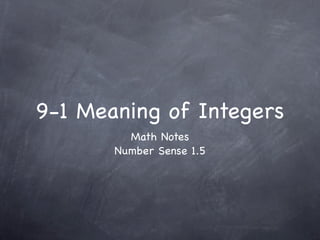9-1 Meaning of Integers
•Download as KEY, PDF•
1 like•422 views
Report
Share
Report
Share

Recommended
Recommended
More Related Content
More from Mel Anthony Pepito
More from Mel Anthony Pepito (20)
Recently uploaded
Recently uploaded (20)
Continuing Bonds Through AI: A Hermeneutic Reflection on Thanabots

Continuing Bonds Through AI: A Hermeneutic Reflection on Thanabots
Event-Driven Architecture Masterclass: Engineering a Robust, High-performance...

Event-Driven Architecture Masterclass: Engineering a Robust, High-performance...
Where to Learn More About FDO _ Richard at FIDO Alliance.pdf

Where to Learn More About FDO _ Richard at FIDO Alliance.pdf
How Red Hat Uses FDO in Device Lifecycle _ Costin and Vitaliy at Red Hat.pdf

How Red Hat Uses FDO in Device Lifecycle _ Costin and Vitaliy at Red Hat.pdf
Extensible Python: Robustness through Addition - PyCon 2024

Extensible Python: Robustness through Addition - PyCon 2024
Microsoft CSP Briefing Pre-Engagement - Questionnaire

Microsoft CSP Briefing Pre-Engagement - Questionnaire
1111 ChatGPT Prompts PDF Free Download - Prompts for ChatGPT

1111 ChatGPT Prompts PDF Free Download - Prompts for ChatGPT
Using IESVE for Room Loads Analysis - UK & Ireland

Using IESVE for Room Loads Analysis - UK & Ireland
Event-Driven Architecture Masterclass: Challenges in Stream Processing

Event-Driven Architecture Masterclass: Challenges in Stream Processing
Long journey of Ruby Standard library at RubyKaigi 2024

Long journey of Ruby Standard library at RubyKaigi 2024
FDO for Camera, Sensor and Networking Device – Commercial Solutions from VinC...

FDO for Camera, Sensor and Networking Device – Commercial Solutions from VinC...
Easier, Faster, and More Powerful – Notes Document Properties Reimagined

Easier, Faster, and More Powerful – Notes Document Properties Reimagined
9-1 Meaning of Integers
- 1. 9-1 Meaning of Integers Math Notes Number Sense 1.5
- 2. Terminology The coldest temperature ever recorded was in Alaska 1972. It was -80˚F. The hottest temperature reached + 134˚F in Death Valley, CA in 1913. The numbers -80 and + 134 are called INTEGERS. INTEGERS consist of WHOLE numbers and their OPPOSITES
- 5. Integers Explained 0
- 6. Integers Explained Zero is neither positive nor negative. 0
- 7. Integers Explained Zero is neither positive nor negative. 0 Positive Positive integers are greater than 0
- 8. Integers Explained Zero is neither positive nor negative. 0 + 1 +2 +3 +4 +5 +6 Positive Positive integers are greater than 0
- 9. Integers Explained Zero is neither positive nor negative. 0 + 1 +2 +3 +4 +5 +6 Negative Positive Negative integers Positive integers are less than 0 are greater than 0
- 10. Integers Explained Zero is neither positive nor negative. -6 -5 -4 -3 -2 - 1 + 1 +2 +3 +4 +5 +6 0 Negative Positive Negative integers Positive integers are less than 0 are greater than 0
- 11. Integers Explained Zero is neither positive nor -5 is the opposite of... negative. -6 -5 -4 -3 -2 - 1 + 1 +2 +3 +4 +5 +6 0 Negative Positive Negative integers Positive integers are less than 0 are greater than 0
- 12. Integers Explained Zero is neither positive nor -5 is the opposite of... negative. +5 ... -6 -5 -4 -3 -2 - 1 + 1 +2 +3 +4 +5 +6 0 Negative Positive Negative integers Positive integers are less than 0 are greater than 0
- 13. Example of Negatives Word Description Integer The lowest temperature recorded in South Dakota is -60 -60˚F 10 steps backwards -10 90 feet below sea level -90
- 14. Example of Positives Word Description Integer The highest temperature +109 recorded in Florida is 109˚F 6 steps forward +6 a gain of 20 yards +20
Editor's Notes
- \n
- \n
- \n
- \n
- \n
- \n
- \n
- \n
- \n
- \n
- \n
- \n
- \n
- \n
- \n
- \n
- \n
- \n
- \n
- \n
- \n
- \n
- \n
- \n
- \n
- \n
